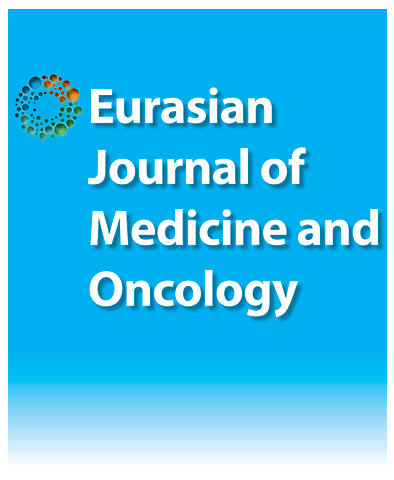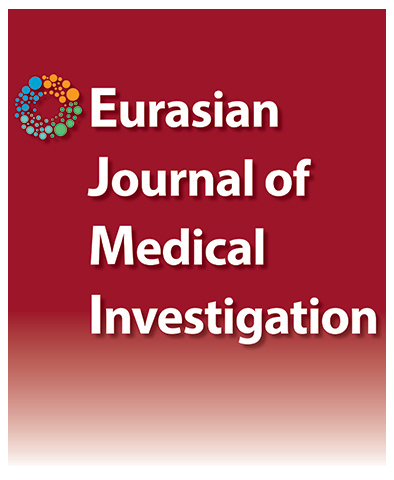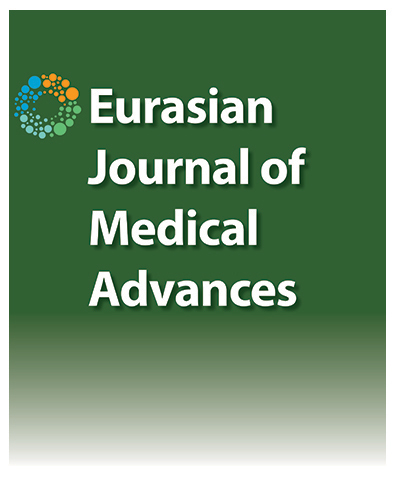Volume: 2 Issue: 4 - 2022
| REVIEW | |
| 1. | Lung Cancer Risk factors - A Review Article Cagnur Elpen Kodaz doi: 10.14744/ejma.2022.36036 Pages 159 - 162 Lung cancer is the most frequent cancer type with high mortality and morbidity rate worldwide. Studies have shown that smoking, environmental factors including occupational exposure, radon exposure, air pollution, radiation, onesity, diet and hereditary susceptibiliy are related to developing risk of LC. By raising public awareness, the incidence of LC can be diminished by preventing modifiable etiological causes of LC, such as effective and practical public health policies and legal regulations restricting tobacco use, studies and regulations to reduce air pollution, and anti-smoking education for all age groups. |
| RESEARCH ARTICLE | |
| 2. | Artificial Intelligence Modeling of the Nominal Gross Domestic Product Values of the G-20 Countries and the Number of COVID-19 Active Cases, New Cases, New Recovery and New Deaths Mustafa Agah Tekindal, Mert Demirsoz, Zeynep Ozel, Ferhan Elmali doi: 10.14744/ejma.2022.39200 Pages 163 - 172 Objectives: In the study, COVID-19 data comprising the nominal gross domestic product values of the G-20 countries for 2019 and the cumulative number of deaths, the cumulative number of patients, the number of people who died due to the disease per day, and the number of people who contracted the disease per day were used. The nominal gross domestic product values per capita comprise 12 categories, 20 countries, and 5 continents. Methods: In the study, prediction models that provide the highest performance were obtained by using machine learning methods, such as Random Forest, KNearest Neighbor (KNN), and Boosting classification algorithms. The predictability results of the models created were 54% for the Boosting algorithms, 80% for the KNN algorithm, 29% for the Linear Discriminant Algorithm, and 86% for the Random Forest algorithm. Results: The descending order of performances for the models is Random Forest, KNN, Boosting, and Linear Discriminant algorithms. Conclusion: Aligned to these results, Random Forest and KNN algorithms showed satisfactory results in estimating the nominal gross domestic product values based on the estimators of cumulative number of deaths, the cumulative number of patients, the number of people who died daily due to the disease, and the daily number of people infected with the disease. |
| 3. | Relevancy of Serum SuPAR, PAI-1, MMP-9 Level, and Prognosis of Metastatic Colorectal Cancer During Diagnosis Mehmet Eren Kalender, Leyla Demir, Utku Oflazoglu, Yuksel Kucukzeybek, Tarik Salman, Umut Varol, Yasar Yildiz, Zeynep Sevgen Güç, Halil Taskaynatan, Ahmet Alacacıoglu doi: 10.14744/ejma.2023.49368 Pages 173 - 180 Objectives: Serum suPAR, PAI-1, and MMP-9 biomarkers have been associated with the progression of the disease in many cancers, including the CRC. It aimed to determine the relation of serum suPAR, PAI-1, and MMP-9 levels with the prognosis of the disease in patients with mCRC. Methods: Nonmetastatic CRC patients who had not yet been treated with the oncology polyclinic in İKCU and blood samples were taken from the patients with metastatic CRC before and after treatment, and the obtained serum was preserved. PAI-1, suPAR, and MMP-9 levels were studied by ELISA. The results were used to establish the relation with prognosis. Results: When the metastatic CRC and non-metastatic CRC were compared before treatment for biomarkers; PAI-1(p-value: 0.030), suPAR(p-value: 0.009) and MMP-9(p-value: 0.003) were found to be highly significant. PAI-1 (p-value: 0.003), suPAR (p-value: 0.007), and MMP-9 (p-value: 0.001) in the pretreatment metastatic group and the control group after the treatment were statistically significant. ROC was performed and cut-off values were determined as (pai: 71.4 ng/ ml; supar: 1.97 ng/ ml; mmp: 812.5 ng/ ml). PFS and OS were evaluated to the cut-offs of markers using the Kaplan-Meier method. Cut off values were significant in terms of PFS (pai p-value, 0.008; supar p-value 0.019, mmp p-value 0.017) and OS (pai p-value, 0.03; supar p-value 0.059, mmp p-value 0.081). Conclusion: Serum PAI-1, suPAR, and MMP-9 levels reveal the prognosis of patients with metastatic CRC. |
| 4. | Molecular Docking and Simulation Study of Calcium Channel Blockers on SARS-CoV-2 ORF3a Protein Hanuman Singh Dagur, Saurabh Singh Dhakar doi: 10.14744/ejma.2022.35229 Pages 181 - 191 Objectives: The covid-19, a viral disease caused by Severe Acute Respiratory Syndrome Coronavirus-2 (SARS-CoV-2), has turned into pandemic. The genome of SARS-CoV-2 encodes 14 open reading frames, produced from transcription of sub genomic RNAs. It encodes for sixteen non-structural proteins, four structural proteins and eight accessory proteins. The accessory protein, ORF3a is a viroporin with ion channel activity and has been shown to be crucial for the viral release and pathogenicity of SARS-CoV-2. Methods: We used a combination of virtual database screening, molecular docking and all-atom molecular dynamics simulation analysis to screen calcium channel blocker drugs as potential inhibitors of ion channel formed by SARS-CoV-2 ORF3a protein. Results: Interaction and molecular dynamics simulation analysis showed that hydrogen bond and hydrophobic interaction were the major driving forces for binding of the drugs, with Niguldipine being the most promising inhibitor. Niguldipine is bound at the lumen of the channel formed by ORF3a protein, indicating as a potential inhibitor of functionality of the viroporin ORF3a protein. In MD simulations, niguldipine demonstrated stable conformational dynamics with SARS-CoV-2 ORF3a protein. Conclusion: Molecular and MD simulation study highlights the possibility of exploring calcium channel blocker drug, niguldipine as a potential SARS-CoV-2 ORF3a protein ion channel blocker to inhibit the viral infection. |
| 5. | Predominant Risk Profiles of Middle-Aged Women Associated With Acute Myocardial Infarction and Coronary Atherosclerosis: A Cross Sectional Study in Macao Weng Chio Tam, U Po Lam, Toi Meng Mok, Man Fai Ip, Monica Pon, Man Fong Chu, Mario Évora doi: 10.14744/ejma.2022.69885 Pages 192 - 199 Objectives: In recent decades, the incidence of acute myocardial infarction (AMI) has increased in younger women. Classically, younger women may experience ischemic and prodromal symptoms before AMI. The aim of this study was to investigate the predominant risk factors related to AMI and the severity of obstructive atherosclerosis in symptomatic young women. Methods: In this cross-sectional study, we retrospectively enrolled females aged between 40 and 65 years, at a single hospital, from January 2014 to December 2021. All females who had clinical symptoms or clinical evidence of coronary ischemia underwent coronary imaging. All participants were categorized into either the with AMI group or the without AMI group. In both groups, we obtained and assessed all of the cardiovascular risk factors, their medical history and basic data. Results: In total, 161 patients were enrolled, of whom 110 (68%) had coronary artery disease. A total of 51 patients (31%) had a higher incidence of hypertension, dyslipidemia, concomitant use of statins, anti-hypertensive drugs and increased low-density lipoprotein-cholesterol (LDL-c) levels before AMI. Multivariate logistic regression showed that only LDL-c level was an independent predictor of AMI (odds ratio [OR]=3.2, 95% confidence interval [CI]=1.9 to 5.45, P<0.001). Moreover, the patients with a low LDL-c level (LDL-c <2.6) had a lower incidence of AMI and a lower syntax score, compared with the higher LDL-c group (LDL-c ≥2.6). The LDL-c level was also significantly correlated with syntax score in the overall population (r=0.43, p<0.0001), those aged 40-55 years (r=0.41, p=0.01) and those aged 56-65 years (r=0.47, p<0.0001). Conclusion: LDL-c level is significantly associated with the risk of AMI and the severity of obstructive atherosclerosis in symptomatic middle-aged women. Intensive clinical control of the LDL-c level may be necessary in this population. |
| 6. | Important Parameters in the Discrimination of Benign and Malign in Fine Needle Aspiration Biopsy in Solid Breast Lesions Özlem Türelik, Ümit Bayol doi: 10.14744/ejma.2022.98698 Pages 200 - 204 Objectives: There are many cytologic features defined to distinguish benign-malignant solid breast lesions. This study was conducted to investigate important additional parameters in the cytological differentiation of benign and malignant solid breast lesions. Methods: We evaluated 99 cases (45 benigni 44 malignant) registered in our laboratory. The cases are investigated in terms of various cytologic parameters. Results: When the results were examined, it was seen that bare cell had diagnostic value in favor of benign. Bipolar cells and bare epithelial cells were not observed in most of the malignant cases. Benign giant cells were not seen in any of the malignant cases. Malignant giant cells were detected in 31.8% of malignant cases. Cytoplasmic vacuoles were observed at the level of 81.8% in malignant cases and 57.8% in benign cases and were evaluated as significant. Dis-cohesive groups were observed at a higher rate in malignant cases and were evaluated as significant. Macronucleolus was found to be significant in the differentiation of benign and malignant. Nucleocytoplasmic ratio increased in all malignant cases. While mitotic activity was not observed in any of the benign cases, it was seen in 20.5% of the malignant cases and was considered significant. Conclusion: Besides well-known criteria, parameters such as metaplastic epithelium, benign/malignant giant cells, epithelial cells amongst the lipomatous stroma and even an artificial sign: cytoplasmic vacuolization should be considered in the cytological differential diagnosis of solid mammary masses. |
| 7. | The Effect of Nail Diameter in Reamed Intramedullary Exchange Nailing Yusuf Murat Altun, Cahit Koçak doi: 10.14744/ejma.2022.63626 Pages 205 - 211 Objectives: Treatment with exchange nailing is the most preferred treatment method in aseptic femoral and tibial diaphyseal non-unions without bone defect. In this study, patients treated with exchange nailing for femoral and tibial diaphyseal non-unions were evaluated clinically and radiologically. The aim of this study was to determine the factors effective in exchange nailing treatment and to evaluate the effect of changing diameter of the nail. Methods: This single-center, retrospective study included 22 patients with femoral diaphyseal non-union and 13 patients with tibial diaphyseal non-union who underwent revision surgery with exchange nailing after diagnosis of non-union following operations of the femur or tibia with intramedullary nailing. Results: Union and healing were determined in all the patients (100%). In the femoral non-union group, the most decisive factor on the time to union was the change in nail diameter. In the tibial non-union group, the most decisive factor on the time to union was comorbidity. Conclusion: Exchange nailing treatment in aseptic femoral and tibial diaphyseal non-unions without bone defect, with fixation using stable locking reamed intramedullary nail is a treatment option with excellent results. The change of nail diameter, especially in femoral non-unions has a positive effect on the time to union. |
| 8. | Does Clinical-Laboratory Workup in COVID-19 Cases Misdiagnosed as Dengue Fever in Tropical Setting or These are Two Sides of Same Coin? Shital Patil, Manojkumar Bhadake, Abhijit Acharya, Gajanan Gondhali doi: 10.14744/ejma.2022.77486 Pages 212 - 220 Objectives: Dengue-covid-19 overlap is mixture of both diseases sharing few similarities in pulmonary and extrapulmonary involvement. Methods: Prospective, multicentric, and observational study conducted during May 2021-September 2021, included 200 Covid-19 cases with dengue NS1 or Dengue IgM positive, with lung involvement documented and categorized on HRCT thorax at entry point. All cases were subjected to dengue IgG antibody titers and dengue IgM/IgG antibody titer analysis after 12 weeks of discharge form hospital after clinical recovery. Statistical analysis is done by using Chi square test. Results: Dengue-Covid-19 overlap was documented in 16.33% (49/300) cases. CT severity has documented significant correlation with Dengue-Covid-19 overlap cases. [p<0.00001] Hematological parameters as white blood cell count & platelet count were having significant association with Dengue-Covid-19 overlap [p<0.0076] & [p<0.00001] respectively. Clinical parameters as hypoxia have significant association with dengue-covid-19 overlap. [p<0.00001] Inflammatory markers as IL-6, CRP and LDH has significant association in dengue-covid-19 overlap [p<0.00001] respectively. In study of 49 cases of ‘Dengue-covid-19’, post covid lung fibrosis [p<0.004] and serological assessment in dengue IgM/IgG and covid antibody titers has significant association [p<0.00001]. Conclusion: ‘Dengue-covid-19’ is disease of concern in ongoing pandemic in critical care setting, high index of suspicion is must as natural trend of this entity is different and it behaves like ‘two sides of same coin’. |
| CASE REPORT | |
| 9. | Maternal and Perinatal Outcome of a Pregnancy Complicated with Dilated Cardiomyopathy Sangam Jha, Jayanti Sinha, Jafeesha Bright Singh doi: 10.14744/ejma.2022.70288 Pages 221 - 223 Dilated cardiomyopathy (DCM) is characterized by ventricular enlargement along with left systolic cardiac dysfunction. In association with pregnancy, it has been classified as pregnancy associated DCM (PADCM) and peripartum cardiomyopathy(PPCM). Herein we report a case of 26 year old G2P1L1 presented at 27weeks of gestation with progressive dyspnea and pedal edema for last 3 weeks. Clinical features of biventricular failure were present. 2D Echocardiogra-phy showed dilated cardiomyopathy, severe mitral regurgitation, ejection fraction 20-25% and mild pulmonary arterial hypertension. Based on these findings PADCM was diagnosed as there was no history of prior cardiac disease. She was started on drugs carvedilol, amiadrone and frusemide along with fluid restriction and strict input/output monitoring. Pregnancy continued till 35 weeks of gestation and then terminated by LSCS. Post-delivery she again landed up in bi-ventricular failure, managed in ICU with carditonic drugs and ventilator support. She recovered after 5 days of intensive care. Pregnancy in women with DCM is at high risk of adverse maternal and perinatal outcome. However early involvement of cardiologist and obstetrician in the management of such cases improves the maternal and fetal outcome. This case report addresses the challenges that pregnancy complicated with DCM poses on the obstetrician. |






